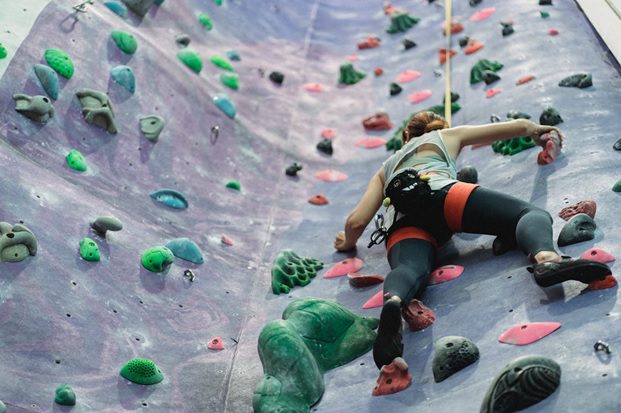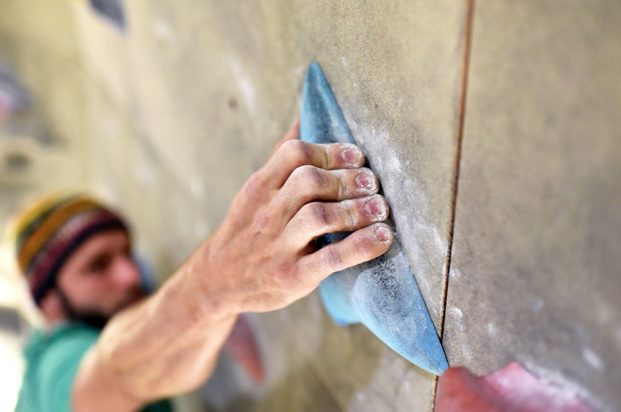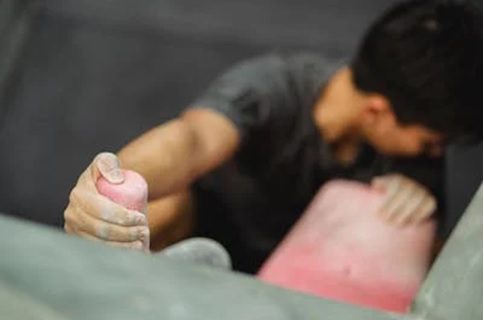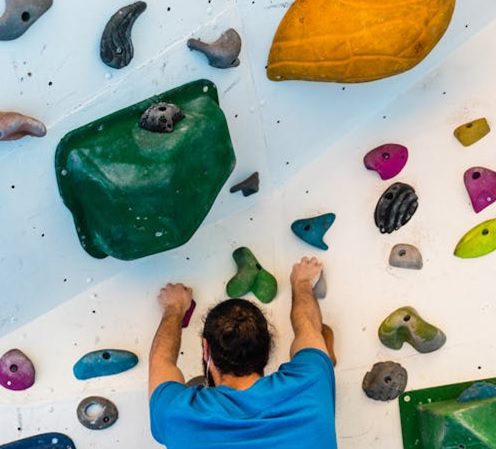
Indoor Rock Climbing for Beginners: Types of Holds
Your first time in a rock climbing gym can be intimidating, even if you go with a seasoned climber. As soon as you get your climbing shoes on you might feel like you’re being bombarded with jargon and lingo you’ve never heard before!
But don’t let that scare you off. With this short guide, you’ll be able to spot and call out many different types of rock climbing holds, just like a bouldering gym veteran!
Jug Handles/Buckets

Jug handles are everyone’s favorite type of hold, because they offer a full, sure grip you can get your entire hand around. This is the reason for the name – they’re like a jug’s “handle” that you can get your full hand through. As a result, most climbers can hang onto these holds without too much exertion, giving a rest and letting you plan your next move at ease.
Because jugs are usually large, ergonomic, and comfortable to grip, they are common on V1/V2 routes, as well as on some V3/V4 routes in bouldering gyms.
Edge or Ledge Holds

Edge holds, also known as ledge holds when the hold is oriented in a linear fashion and parallel to the ground, are usually much narrower than jugs. These are among the most common holds you will encounter on the climbing wall in an indoor climbing gym.
The thing about edges is that they can face any direction with respect to the wall, and they can be very wide, wide enough for your whole hand or climbing shoe, or extremely narrow – in which case they’re referred to as crimps.
Crimp Holds
Crimps are tiny edge holds, usually so narrow you can only get the tips of your fingers around them, at most up to the first knuckle.
Crimp holds can present a big challenge for beginner climbers because they place a lot of pressure on the tendons in your hand, and hanging onto one for long will make you tired quickly. Even experienced climbers don’t hang onto crimps for longer than is necessary.
There are two ways to grip a crimp hold – with a full crimp or an open crimp. With a full crimp, your knuckles will be angled sharply, and some climbers place their thumb over their index or middle finger for extra power. With an open crimp, your fingers will be less sharply angled and your hand may be flat against the face of the hold, or the wall.
Pockets
Pockets are a special type of hold – or rather a feature of a hold, as any hold that has a hole in it may be referred to as a pocket, or as having a pocket.
Pockets may be big holes, enough for you to get all four fingers in, or they may be very small. In some instances, pockets may be so small that you can only get one finger inside. In such case, the pocket can be referred to as a “mono.” When attempting a mono, use your middle finger, as that is your strongest finger.
If the pocket is shallow or you can’t get your fingers all the way in, it might be called a divot.
Slopers
Slopers are a tricky type of hold associated with tough bouldering problems. Slopers have no defined edges or corners, making it difficult to get a good grip on them as there is nothing to get your fingers around. The hand must be open or cupped when attempting to get a solid hold on a sloper.
To grip a sloper, you need to use the friction from your fingers and palm as there is nothing to wrap around. Slopers can be either very large or very small but all are challenging as they don’t afford a positive grip. Often, the difficulty of a sloper runs in proportion to the angle it makes with the wall.
Pinch Holds
A pinch hold is a lot like a crimp hold (or an edge). The difference is with a pinch, the hold is narrow enough that you can get your thumb around it. This gives you a lot more leverage with pinch grips that you wouldn’t have with edges or crimps. Don’t underestimate the power your thumb adds when climbing; use it on any pinch you come across and don’t let your other fingers work alone!
Horns and Underclings

Horns are a type of hold that usually sticks off the wall – like a horn, giving rise to the name. Usually, you can get your whole hand around a horn, but they’re not as “juggy” because often you can’t close your grip around anything. This makes most horns better than slopers, but not as secure as true jugs. Still, when approached properly, a horn can provide a very sure, secure grip.
Underclings are not so much a type of hold as they are a jug that is used in a certain way, being that you grip it from the bottom and pull upward. To maintain a good grip on an undercling, you usually need a solid foothold relatively close to it so you can maintain upward tension as you reach for the next hold in the route.
A Note on Volumes (the Green Things Pictured in the Image Below)

Many bouldering gyms will use volumes in their routes, which are not technically holds, but are parts of the wall, or big blocks that protrude from the wall. Most indoor climbing gyms will permit you to use them. If the volume has an edge, you can use it as a hold, and even if it doesn’t you may be able to use it for smearing. Smearing refers to the process of pressing your hand or foot against the wall for friction or stability.
Indoor Rock Climbing for Beginners: Get Started Today!
Thinking about signing up with an indoor climbing gym? We make it easy with options for indoor rock climbing for beginners, we even offer day passes and gear rentals, including shoes and chalk bags. Harnesses and lead tops for top rope climbing.
And, now that you’re familiar with these main types of holds, you’ll be talking the climbing and bouldering lingo in no time. Send it!


No Comments